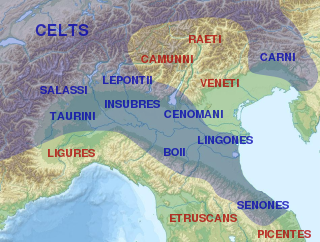Related Research Articles

The Taurini were a Celto-Ligurian tribe dwelling in the upper valley of the river Po, around present-day Turin, during the Iron Age and the Roman period.
The Deciates (Δεκιήταις) were a Ligurian tribe dwelling near on the Mediterranean coast, around present-day Antibes, during the Iron Age and the Roman era.
The Oxybii or Oxubii were a Celto-Ligurian tribe dwelling on the Mediterranean coast during the Iron Age and the Roman period.
The Reii were a Celto-Ligurian tribe dwelling in the modern department of Alpes-de-Haute-Provence during the Iron Age and the Roman period.
The Salyes or Salluvii were an ancient Celto-Ligurian people dwelling between the Durance river and the Greek colony of Massalia during the Iron Age. Although earlier writers called them 'Ligurian', Strabo used the denomination 'Celto-ligurian', and a Celtic influence is noticeable in their religion, which centred on the cult of the tête coupée. In fact, the Salyes were most likely at the head of a political and military confederation that united both Gallic and Ligurian tribes.
The Marici were a Celto-Ligurian tribe dwelling around present-day Pavia (Lombardy) during the Iron Age.
The Avatici were a Gallic tribe dwelling near the Étang de Berre, between the mouth of the Rhône river and Massilia, during the Roman period.
The Dexivates were a small Gallic tribe dwelling in the southern part of modern Vaucluse, near the present-day village of Cadenet, during the Iron Age and the Roman period.
The Avantici were a small Gallic tribe dwelling around present-day Gap, in the western part of the modern Hautes-Alpes department, during the Roman period.
The Vediantii were a Celto-Ligurian tribe dwelling on the Mediterranean coast, near present-day Nice, during the Iron Age and the Roman period.
The Intimilii or Intemelii were a Ligurian tribe dwelling on the Mediterranean coast, around present-day Ventimiglia, during the Iron Age and the Roman period.
The Ingauni were a Celto-Ligurian tribe dwelling on the Mediterranean coast, around the modern city of Albenga (Liguria), during the Iron Age and the Roman period.
The Suetrii or Suetri were a Gallic tribe dwelling around present-day Castellane (Alpes-de-Haute-Provence) during the Iron Age and the Roman period.
The Bodiontici or Brodiontii were a Gallic tribe dwelling around present-day Digne (Alpes-de-Haute-Provence) during the Roman period.
The Nemeturii or Nemeturi were a Gallic tribe dwelling in the Alpes Maritimae during the Iron Age.
The Ecdinii or Ecdini were a Gallic tribe dwelling in the valley of the Tinée (Alpes-Maritimes) during the Iron Age.
The Vesubiani or Vesubianii were a Gallic tribe dwelling in the valley of the Vésubie river during the Iron Age.
The Sogionti or Sogiontii were a Gallic tribe dwelling around present-day Sisteron during the Iron Age.
The Rucinates or Runicates were a Gallic tribe dwelling in near the confluence of the Isar and Danube rivers during the Roman period.
The Catenates or Cattenates were a Gallic tribe dwelling between the Isar and Inn rivers during the Iron Age.
References
- ↑ Pliny. Naturalis Historia, 3:35.
- 1 2 Falileyev 2010, s.v. Ligauni.
- ↑ Barruol 1969, p. 215.
- 1 2 de Bernardo Stempel 2006, p. 46.
- ↑ Talbert 2000, Map 16: Col. Forum Iulii-Albingaunum.
- ↑ Barruol 1969, p. 188.
- ↑ Rivet 1988, p. 16.
Bibliography
- Barruol, Guy (1969). Les Peuples préromains du Sud-Est de la Gaule: étude de géographie historique. E. de Boccard. OCLC 3279201.
- de Bernardo Stempel, Patrizia (2006). "From Ligury to Spain: Unaccented *yo > (y)e in Narbonensic votives ('gaulish' DEKANTEM), Hispanic coins ('iberian' -(sk)en) and some theonyms". Palaeohispanica. 6: 45–58. ISSN 1578-5386.
- Falileyev, Alexander (2010). Dictionary of Continental Celtic Place-names: A Celtic Companion to the Barrington Atlas of the Greek and Roman World. CMCS. ISBN 978-0955718236.
- Rivet, A. L. F. (1988). Gallia Narbonensis: With a Chapter on Alpes Maritimae : Southern France in Roman Times. Batsford. ISBN 978-0-7134-5860-2.
- Talbert, Richard J. A. (2000). Barrington Atlas of the Greek and Roman World. Princeton University Press. ISBN 978-0691031699.
